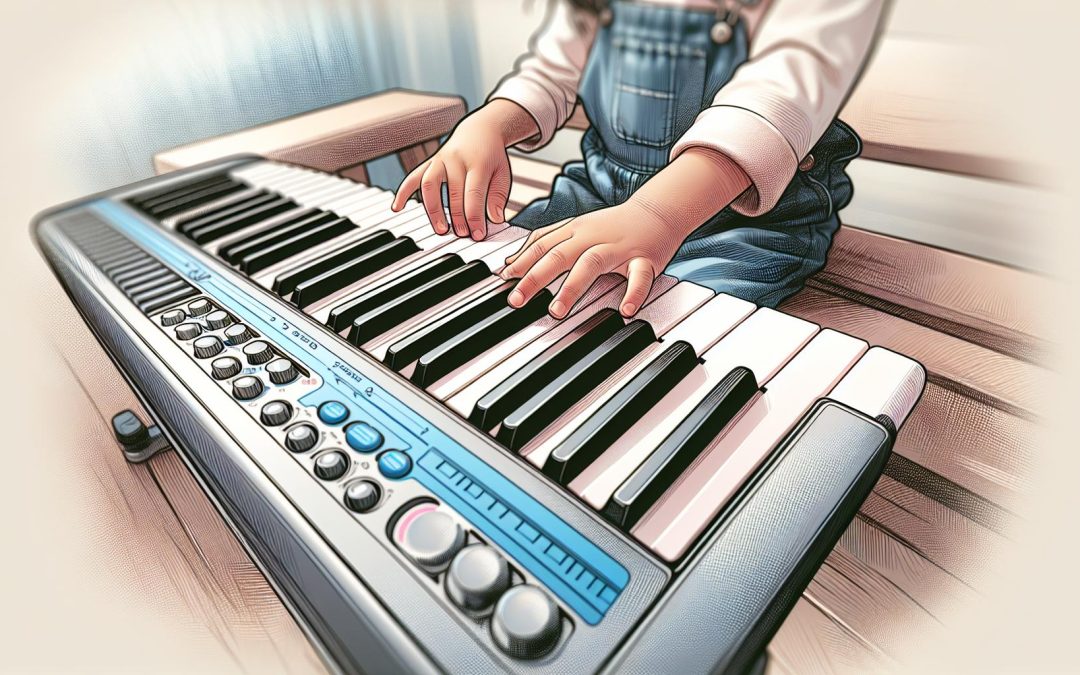Selecting the perfect beginner keyboard for small hands can seem like a daunting task, but it's crucial for ensuring a comfortable and enjoyable learning experience. With the right instrument, those early stages of musical exploration become much more accessible and fun.
Manufacturers have recognized the need for more inclusive designs, and today's market offers a variety of keyboards tailored to smaller hands. These models often feature narrower keys and a more compact layout, making it easier for beginners to reach chords and melodies without strain. Whether it's for a young child or an adult with petite hands, finding the right keyboard can make all the difference in sparking a lifelong passion for music.
Understanding the needs of small-handed players
Selecting the right keyboard for beginners with small hands isn't just about the size; it's about ensuring a comfortable and enjoyable experience that encourages continuous learning and practice. Small-handed players, be they children or adults, face unique challenges that can impact their learning curve and overall interest in music. Understanding these challenges is key to making an informed choice.
Firstly, the stretch required for octave plays or complex chords on a standard keyboard can lead to discomfort or even strain for those with smaller hands. This struggle can deter learners, making practices less effective and, over time, diminishing their zeal to continue. Keyboards designed with a more compact layout address this issue by reducing the distance between keys, thereby making it easier for small hands to navigate complex musical pieces without unnecessary strain.
Another aspect to consider is the weight of the keys. Beginners, particularly children, might find the weighted keys of a traditional piano too hard to press down. Keyboards with lighter, more responsive keys can make a significant difference in playability, allowing for easier and more nuanced control over the music.
Manufacturers have recognized these needs and have begun to offer models that cater specifically to this demographic. Features like reduced key sizes, lighter action, and slim profiles not only accommodate the physical constraints of smaller hands but also help in building confidence and skill over time.
Key Characteristics to Look For
When shopping for the perfect beginner keyboard for small hands, keep an eye out for the following features:
- Reduced key size: Slightly narrower keys can make a big difference in playability for small hands.
- Lighter key action: Keyboards with a lighter touch response are easier to play, especially for young learners.
- Compact design: A slimmer profile and reduced width can help small-handed players reach all keys comfortably.
| Feature | Benefit for Small-Handed Players |
|---|---|
| Reduced key size | Easier chord and melody play |
| Lighter key action | Less finger strain, more nuanced control |
| Compact design | Comfortable reach for both hands |
Factors to consider when choosing a beginner keyboard

When selecting a beginner keyboard for small hands, it's essential to consider several key factors that can significantly impact a learner's experience. Understanding these aspects will help ensure that the keyboard not only fits the player's physical needs but also supports their musical development.
Key Size and Action
The size of the keys and their action—how they respond to touch—are crucial for small-handed individuals. Standard keyboards might pose a challenge, as their keys could be too wide and heavy, making it difficult for a learner to play comfortably.
- Reduced Key Size: Look for keyboards with slightly smaller keys. This adjustment can make a world of difference, enabling easier reach and less strain.
- Lighter Key Action: Keyboards with a lighter touch require less force to press the keys. This is especially beneficial for beginners who might not yet have developed strong finger muscles.
Compact Design
A keyboard’s overall design plays a significant role in accessibility and comfort. Compact models are more suited for learners with small hands, as they often include a smaller keybed and a more manageable overall size, ensuring that players can reach the entire range without overstretching.
- Number of Keys: Beginner keyboards typically range from 61 to 76 keys, fewer than the 88 keys of a standard piano. This reduction not only makes the instrument more compact but also less daunting for new players.
Additional Features to Enhance Learning
Beyond the physical characteristics of the keyboard, certain features can make learning more enjoyable and efficient for beginners.
- Built-In Lessons: Some keyboards come equipped with interactive learning tools, such as built-in lessons or light-up keys, to guide beginners through their first songs.
- Headphone Jack: For learners, being able to practice without worrying about disturbing others can be a bonus. A headphone jack allows for private practice sessions, encouraging more practice time.
- Recording Capability: Being able to record and playback one's playing can be incredibly beneficial for progress tracking and self-evaluation.
- High-Quality Sounds: Quality sound can make practice sessions more rewarding and enjoyable, encouraging learners to spend more time with their instrument.
- Variety of Voices: Having a range of instrument voices and sound effects can keep practice engaging and fun, allowing beginners to
Top beginner keyboards designed for small hands

When embarking on the musical journey, beginners with smaller hands should consider keyboards specifically designed to accommodate their unique needs. Manufacturers have recognized the importance of creating instruments that cater to a broader range of players, including younger individuals or those with petite hand sizes. This section highlights some of the best beginner keyboards suitable for small hands, ensuring that the path to becoming a proficient pianist is as comfortable and enjoyable as possible.
Yamaha Piaggero NP-12
One of the standout options is the Yamaha Piaggero NP-12. This keyboard features a slim and lightweight design, making it ideal for small spaces and easy transport. With 61 keys, it provides a reduced key size which is perfect for players with smaller hand spans. Despite its compact size, the NP-12 doesn't compromise on quality. It boasts Yamaha's Advanced Wave Memory Stereo Sampling, delivering rich and expressive sounds that inspire beginners to keep practicing.
Casio SA-76
For those seeking a budget-friendly option, the Casio SA-76 is an excellent choice. It is specifically designed for children and beginners, featuring 44 mini-sized keys that are perfect for small fingers. The SA-76 doesn't skimp on features, offering 100 tones, 50 rhythms, and 10 integrated songs for varied practice sessions. Its simple operation and playful design encourage consistent practice and exploration.
Roland GO:KEYS GO-61K
The Roland GO:KEYS GO-61K is another fantastic option that caters to beginners with small hands. This innovative keyboard introduces a unique approach to playing and learning music. It comes equipped with 61 touch-sensitive keys with a reduced size, making it easier for small hands to navigate. What sets the GO:KEYS apart is its loop mix function, allowing players to build songs by simply triggering looped phrases and beats. This interactive feature brings an element of fun and creativity to practice sessions, making learning an engaging experience.
Tips for optimal playing experience

Choosing the right beginner keyboard for small hands is just the first step in a musical journey. Beyond the selection of an instrument, adopting proper techniques and practices can significantly enhance the playing experience. When embarking on this path, beginners should consider the following advice to ensure they're not only comfortable but also making the most of their practice sessions.
Proper Posture and Keyboard Placement
A foundational aspect of playing the keyboard effectively, especially with smaller hands, is maintaining good posture. Sitting upright, yet relaxed, allows players to reach keys more easily without straining. The keyboard should be positioned at a height where the forearms are parallel to the floor when the hands are on the keys. This alignment helps in reducing fatigue and improving accuracy during playing.
Adjustable Benches and Pedals
Investing in an adjustable bench can make a significant difference in finding the right playing position. It allows players of all sizes to adjust their seating height to the optimal level for easy access to the entire keyboard. Similarly, beginners with small hands may find pedal extenders useful. These devices help in comfortably reaching the pedals without having to stretch or adopt awkward positions.
Hand Positioning and Finger Techniques
For those with small hands, mastering hand positioning and finger techniques is crucial. They're advised to:
- Keep their fingers curved, as if holding a small ball.
- Use the tips of their fingers to press the keys, avoiding flat finger playing.
- Practice scales and exercises designed to improve finger strength and dexterity, which can make playing more fluid and reduce the effort needed to press the keys.
Utilizing Keyboard Features
Modern beginner keyboards come equipped with features designed to support learning and make playing easier. Here are a few functionalities to look for:
- Touch sensitivity: Adjusting touch sensitivity can help players with smaller hands not to have to press as hard to produce sound.
- Key lighting: Some keyboards have keys that light up to show players which notes to play, providing visual guidance.
Regular Practice and Patience
Consistency is key in mastering any new skill, and learning to play the keyboard is no exception. Regular practice sessions, even if they're short, can lead to steady progress. Break up practice into focused sessions targeting specific skills or pieces. And remember, patience is essential. Progress might seem slow at first, but with time and dedication, improvement will become noticeable.
Conclusion
Choosing the right beginner keyboard for small hands can make a world of difference in a budding musician's journey. With options like the Yamaha Piaggero NP-12, Casio SA-76, and Roland GO:KEYS GO-61K, there's a perfect fit out there for everyone. Remember, it's not just about the instrument but also how you use it. Embracing proper posture, adjusting your setup, and mastering hand positioning are key to a comfortable and rewarding playing experience. And let's not forget the power of practice and patience. With these insights, you're well on your way to making beautiful music that feels as good as it sounds.
Harlan Kilstein began playing piano during covid with no piano background at all. He taught himself how to play learning what to do and what not to do.
Today he's an advanced intermediate player and can help you grow in your skills because he learned all this on his own.







